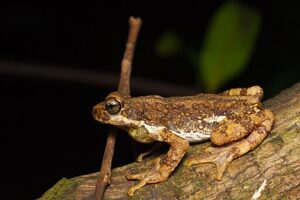Physical Address
23,24,25 & 26, 2nd Floor, Software Technology Park India, Opp: Garware Stadium,MIDC, Chikalthana, Aurangabad, Maharashtra – 431001 India
Physical Address
23,24,25 & 26, 2nd Floor, Software Technology Park India, Opp: Garware Stadium,MIDC, Chikalthana, Aurangabad, Maharashtra – 431001 India

By Vivek Saini
In the lush Western Ghats of India, the Malabar Tree Toad (Pedostibes tuberculosus), a unique arboreal amphibian, faces a scary future due to climate change. Known for its exclusive tree-dwelling lifestyle and specialised breeding habits, this rare toad is projected to experience a staggering population decline of up to 70% by 2080. As climate shifts disrupt its delicate habitat and breeding cycles, the Malabar Tree Toad’s plight underscores the broader ecological threats looming over this UNESCO World Heritage site’s rich biodiversity.
A Unique Arboreal Toad at Risk
The Malabar Tree Toad (Pedostibes tuberculosus) is a rare and unique species residing exclusively in India’s Western Ghats. Unlike most toads that are ground-dwelling, this species is arboreal, meaning it has adapted to living in trees, making it the only tree-dwelling species of its kind in India. This species was first described in 1876, but due to its elusive nature and dense, often inaccessible habitats, it went unobserved for over a century. It wasn’t until 1980 that the toad was rediscovered in Kerala’s Silent Valley National Park, sparking renewed interest among herpetologists and conservationists. The Malabar Tree Toad’s ability to climb and dwell in trees, alongside its specialised breeding habits during the monsoon, make it an intriguing yet vulnerable species.
The Western Ghats, a UNESCO World Heritage site, is known for its rich biodiversity, hosting many endemic species. However, the Malabar Tree Toad faces severe threats due to climate change, habitat fragmentation, and deforestation. This toad is particularly sensitive to environmental changes because it relies on specific microhabitats for breeding and survival. The species’ dependence on the monsoon season for breeding, where it descends to ground-level water pools, further complicates its survival as climate change disrupts rainfall patterns. The Malabar Tree Toad’s precarious existence highlights the fragile nature of many endemic species in biodiversity hotspots, where even minor environmental changes can have devastating effects.
Study Highlights Climate Change Impact on Species Distribution
A recent study published in the journal Nature has revealed alarming predictions for the Malabar Tree Toad, forecasting that its population could decline by as much as 68.7% by 2080 due to climate change. The study used advanced species distribution modelling, incorporating various climate change scenarios, to estimate the future distribution of the toad. Under scenarios with high greenhouse gas emissions, the toad’s habitat range is expected to shrink drastically, particularly in the central Western Ghats. This region is projected to become increasingly unsuitable for the species, while the southern Western Ghats might offer slightly more refuge under specific lower emission scenarios.
The study’s findings are a sobering reminder of the broader impacts of climate change on biodiversity. Amphibians, like the Malabar Tree Toad, are especially vulnerable due to their limited thermal tolerance and specific habitat needs. The study notes that suitable habitats could be expanded in more favourable low-emission scenarios in the southern Western Ghats. However, the overall trend remains one of significant habitat loss and fragmentation. These changes affect the Malabar Tree Toad and other species that share its habitat, underscoring the urgent need for climate action to preserve these fragile ecosystems.
Implications for Biodiversity in the Western Ghats
The decline of the Malabar Tree Toad indicates the broader threats facing biodiversity in the Western Ghats. This region is home to around 252 amphibian species, 17 critically endangered. The Western Ghats is recognised globally as a biodiversity hotspot, meaning it contains many species found nowhere else on Earth but is also under significant threat. Amphibians are susceptible to environmental changes due to their permeable skin and reliance on specific microhabitats for survival. The predicted decline in the Malabar Tree Toad population due to climate change could have cascading effects on the region’s ecological balance, impacting not just amphibians but also the flora and fauna that are intricately connected within this ecosystem.
The Western Ghats has already witnessed extensive habitat loss due to human activities such as deforestation, agriculture, and infrastructure development. Climate change adds another layer of complexity, exacerbating these existing threats. As habitats become fragmented, species like the Malabar Tree Toad may struggle to find suitable environments, leading to declining populations. Additionally, changes in precipitation patterns could alter the breeding cycles of amphibians, leading to further population declines. The ongoing loss of biodiversity in the Western Ghats highlights the urgent need for integrated conservation strategies that address habitat preservation and climate change mitigation.
References:
https://en.wikipedia.org/wiki/Malabar_Tree_Toad
https://www.nature.com/articles/s41598-024-60785-1
Banner image:
Photo by Hari on Wikimedia Commons